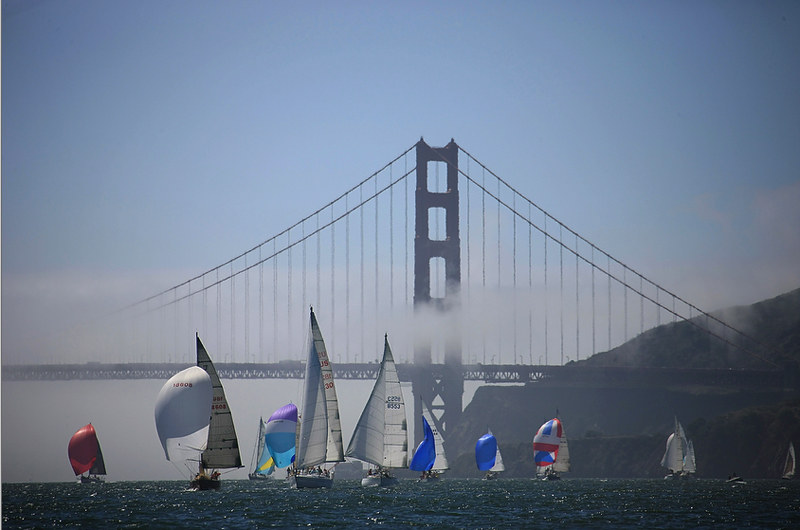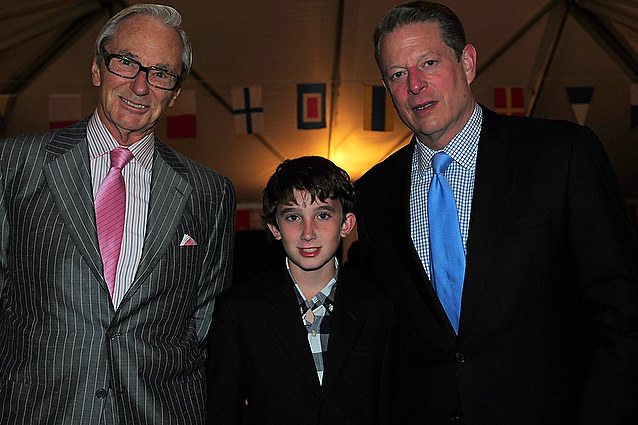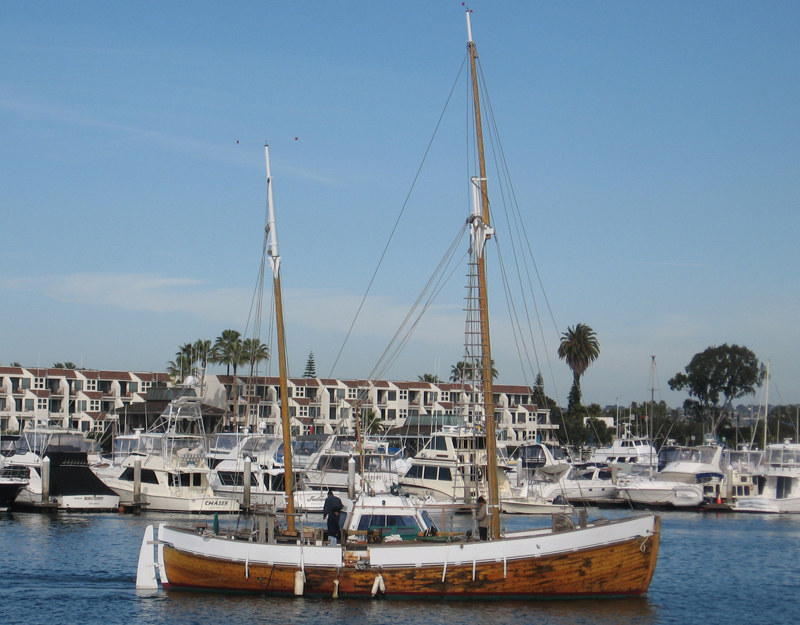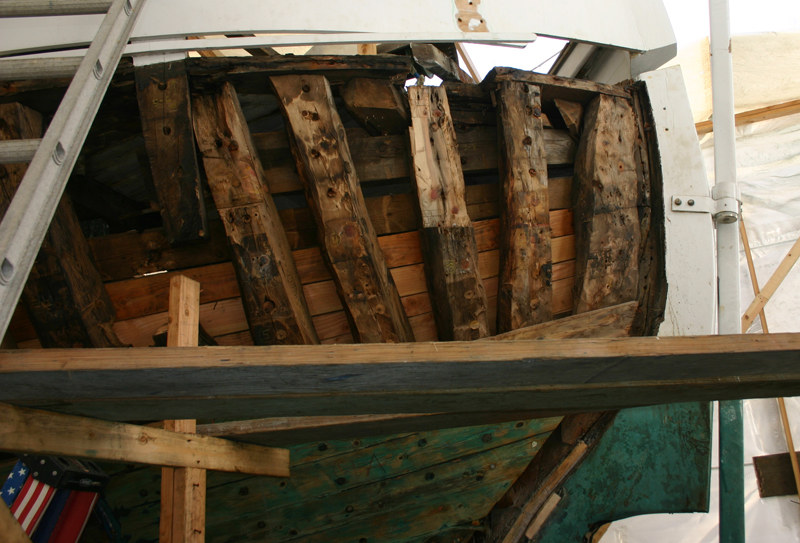
Sunset Quiz
We often receive fantastic sunset shots from cruisers scattered all over the globe, but this one, snapped recently by Jo Brosnan, caught our attention as being unusually spectacular. Tell us where you think it was taken — the first five correct answers get a Latitude bumper sticker! We’ll announce the winners — and the location — in Friday’s ‘Lectronic.
Update: We’ve got our five winners. Thanks everyone for playing!
$630K and Counting

The 2009 Leukemia Cup hosted by the San Francisco YC produced a lot more than winners in the 10 one-design and six handicap divisions. We’re happy to report that, as of this morning, the regatta’s fundraising figures are up to $630,000 in only its fourth year — matching last years’s record haul thanks in part to an anonymous $250,000 donation.

There was a keynote address Saturday night by the country’s former V.P. Al Gore that we’ve heard was very upbeat. Over 100 boats showed for the big boat classes, with the one-design racing run on Saturday by St. Francis YC and the handicap racing by San Francisco YC on Sunday. Seventy-two Optimists also came out for two days, hosted by SFYC, which also counted as the class’s Pacific Coast Championships. And the winners were:
J/105 Donkey Jack, Rolf Kaiser
Melges 24 Bones, Robert Harf
Knarr Adelante, Don Nazzal
IOD Fjaer, Rich Pearce
Club Nautique/West Marine Scout, David Hayward
Opti Blue Will Cefali
Opti Red Dane Wilson
Opti White Jack Johansson
Opti Green William Buckstaff
Division 1 (PHRF < 79) Double Trouble, J/125 Andy Costello
Division 4 (Non-Spin < 130) Q, Schumacher 40, Glenn & Gaby Isaacson
Division 5 (PHRF 81- 135) Yucca, 8-Meter, Hank Easom
Division 6 (Non-Spin >131) Eastern Breeze, J/30, Chris Kostancecki
Division 8 (PHRF > 137) Brigadoon, Custom Blackwatch, Bob Horton
After 89 Years, Still Going Strong

Some sailors have a soft spot for old wooden classics. Cap’n Thaddeous Blanchard of San Diego counts himself among them. While most boaters would be horrified at the prospect of replanking an 85-ft double-ender like Cloudia, Thaddeous has taken the challenge in stride.
After recently buying this 1920 Colin Archer, he realized that finding the necessary vertical-grain planks would be one of the greatest challenges he’d face while refurbishing her. No worries. He bought a semi truck and set out on a mission: scrounging for appropriate wood all the way from Alaska to Eugene, OR. "I managed to get 7,000 board feet of Alaskan yellow cedar to redo the entire hull one last time," he reports. "You don’t want to know how much it cost for the lumber and the fastenings, but I have helped the economy more than the government, that’s for certain."

With any luck, Cloudia will soon be chartering out of San Diego, and Thaddeous is determined to enter her in the 2010 Baja Ha-Ha rally. Look for more on this ambitious project in the upcoming edition of Latitude 38.
Health Insurance in Mexico
In Monday’s ‘Lectronic, we made a second-hand reference to an article about a health insurance plan in Mexico that’s available to Americans and is stunningly inexpensive yet comprehensive. We didn’t know where the article appeared but, fortunately, reader Bob Patton came to the rescue. The article by Chuck Hawley — not the former Singlehanded TransPac’er and West Marine honcho of the same name — appeared in the September 1 issue of USA Today. The first paragraph reads as follows:
"It sounds almost too good to be true: a health care plan with no limits, no deductibles, free medicines, tests, X-rays, eyeglasses, even dental work — for a flat fee of $250 or less a year."
If complete health and dental care for about $20 a month sounds interesting to you, visit http://www.banderasnews.com/
John Skoriak of Sausalito writes that he’s familiar with the plan. It’s his understanding, however, that it requires Americans to have FM-3 residency status to qualify. Many cruisers get this status, rather than a typical tourist visa, for a variety of reasons. It takes about three weeks to get an FM-3, and requires some kind of address in Mexico. That shouldn’t be a problem, however.
According to Skoriak, "if Americans get the FM-3 residency visa, the coverage can be very good depending on where the resident is located and the facilities available in the area. A good working knowledge of Spanish would be very helpful as well, but not necessary. Some of the hospitals in Mexico are excellent, and the CIMA in Hermosillo is world class. The Naval Hospital in Guaymas is also said be to very good, but will only treat foreign residents for acute care and emergencies, not chronic care. They are reported to be world class for things like hip surgeries.
"The IMSS system in Mexico is a socialized medical system. IMSS stands for ‘Instituto Mexicano del Seguro Social’, basically, Mexican ‘Social Security’. The federal government owns, manages and controls how the clinics and hospitals are run. Physicians — both primary care and specialists — are paid a set salary by the government. A government formula of meds is strictly adhered to, and the wait for care may be considerably longer than a private system, especially when one needs to see a specialist.
"Foreign residents are assigned a family doctor for everyday problems. For more complex health issues and doctor references to a specialist, it may take a week or more. It depends on the area.
"The coverage provides for all prescription medicines, x-rays, blood tests, urine tests, complete physicals and monthly check-ups as needed. There is no charge for any visits, services or medicines. The cost is about $200-300 a year depending on the resident’s age and other factors. After that, the individual is covered, and just needs to present a card for services or basic meds.
"There are many medical plans for foreign tourists in Mexico, or even long-term residents who do not get an FM-3 or FM-2 visa, but rather the normal FM-T six-month (renewable) tourist visa. These plans are very inexpensive compared to U.S. health plans and HMOs because the services in Mexico are so much less expensive. There is also ‘fee for service’ available at any hospital or clinic in Mexico, where the foreigner just pays for services rendered. Prices are a fraction of what they are in the U.S. Most areas in Mexico have a strong ‘Cruz Roja’ — Mexican Red Cross — presence, and even small villages generally have an ambulancia.
"Health Care in Mexico has improved considerably in the last 10 years, and foreigners visiting facilities in bigger towns and cities may see little difference between the treatment in Mexico and the treatment in U.S."
As we’ve said many times before, a thrifty cruiser can thrive in Mexico on what would be a poverty income in the United States. Much lower health care costs are just one of the reasons why. We’re not suggesting that life on a boat in Mexico would appeal to all, but it might to some.
